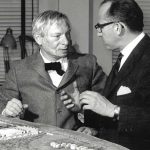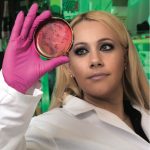In an attempt to provide a more objective scale for research and diagnosis, Terrence Sejnowski, first author David Peterson and colleagues have developed a computer program that takes over the job, analyzing videos of patients’ faces. The program could eventually be expanded to help study facial tics and twitches in other contexts, including Tourette syndrome, schizophrenia and Parkinson’s disease. The research was described online on October 21, 2016, in Neurology, the medical journal of the American Academy of Neurology.
Read News ReleaseNeuroscience
“Princess Leia” brainwaves help sleeping brain store memories
Building a better brain
When you build models, whether ships or cars, you want them to be as much like the real deal as possible. This quality is even more crucial for building model organs, because disease treatments developed from these models have to be safe and effective for humans. Salk Professor Joseph Ecker, first author Chongyuan Luo and European collaborators have studied a 3D “mini-brain” grown from human stem cells and found it to be structurally and functionally more similar to real brains than the 2D models in widespread use. The discovery, appearing in the December 20, 2016, issue of Cell Reports, indicates that the new model could better help scientists understand brain development as well as neurological diseases like Alzheimer’s or schizophrenia.
Read News ReleaseWorms have teenage ambivalence, too
Work by Sreekanth Chalasani’s lab suggests that, in both roundworms and humans, adolescent brains mature to stable adult brains by changing which brain cells they use to generate behavior. Teen worm brains drive wishy-washy behavior that allows them to stay flexible in an uncertain world, while adult worm brains drive efficient behavior. The discovery, published online in eNeuro in January by Chalasani, first author Laura Hale and colleagues, provides insight into the underlying drivers of neurological development that could help better understand the human brain and disease.
Featured Stories
 A Masterful DesignMaintaining the Salk Institute’s iconic architectural vision.
A Masterful DesignMaintaining the Salk Institute’s iconic architectural vision. Inside the Mind of Ted WaittWhether it’s vital funding, imaginative technology or the perspective of a successful CEO, new Board Chair Ted Waitt says adding a little magic in the right place enables great discoveries.
Inside the Mind of Ted WaittWhether it’s vital funding, imaginative technology or the perspective of a successful CEO, new Board Chair Ted Waitt says adding a little magic in the right place enables great discoveries. Surviving SuperbugsWe’re losing the war with infectious diseases. Ending the arms race with infectious diseases could mean learning to live with them.
Surviving SuperbugsWe’re losing the war with infectious diseases. Ending the arms race with infectious diseases could mean learning to live with them.
















































